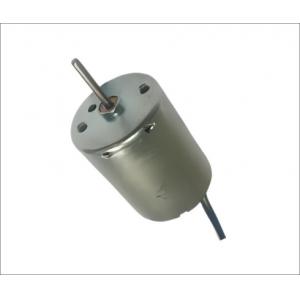
Add to Cart
Essential Details
Efficiency: IE 1
Warranty: 3 Years
Model Number: KG-2838DC24
Rated Voltage: 6-24V
Rated Speed: 3000-10000RPM
Rated Power: 4.3-4.5W
Continuous Current: 0.9-3A
Place of Origin: Guangdong, China
Type: Brushless DC Motor
Application: Fan
Output Power: 1W
Rated Torque: 700-900g.cm
Protect Feature: Other
Lead Time
| Quantity | 1-1000 | 1001-10000 | ≥10000 |
| Lead days | 15 | 30 | To be negotation |
Product Description
| Continuous Current | 0.9-3A | Rated Voltage | 6-24V |
| Rated Power | 4.3-4.5W | Rated Torque | 700-900g.cm |
Drawing

Sample

Application

Motors can be constructed in several different physical configurations. In the conventional (also known as inrunner) configuration, the permanent magnets are part of the radially center core. In the outrunner (or external-rotor) configuration, the radial-relationship between the coils and magnets is reversed. The stator coils in the outrunner configuration form the center core of the motor, while the permanent magnets spin within an overhanging rotor which surrounds the core.
The brushless motor uses a permanent magnet to make a rotor, and there is no coil in the rotor. Since there are no coils in the rotor, commutators and brushes for electrification are not required. Instead, the coil serves as the stator.
The origin of the brushless motor is relatively simple from the beginning: most of the problems of the brushed DC motor come from the brush. Brushes can spark, wear, make a lot of noise and generate a large portion of power consumption, resulting in severely limited speed and not easy to cool.
This means that you cannot use brushed DC motors around anything flammable, in applications that require long service life, silence or high efficiency, in any high-speed or high-power system.
Working Of The BLDC Motor
The starting-current setup in the circuit through the stator windings sets up a magnetomotive force (mmf) which is perpendicular to the main mmf set up by the permanent magnet. According to Fleming’s left-hand rule, a force is experienced by the armature conductors. As the armature conductors are in the stator, a reactive force develops a torque in the rotor. When this torque is more than the load torque and frictional torque, the motor begins rotating.
The process of removing current from one circuit and giving it to another circuit is known as commutation.
The phase current and developed torque in the Brushless DC Motor. In every case there are two phases that are contributing to positive torque and one phase contributing to zero torque. If the torque of each commutation interval is combined, the total torque is a contribution of two torques from two phases that are perfectly flat.